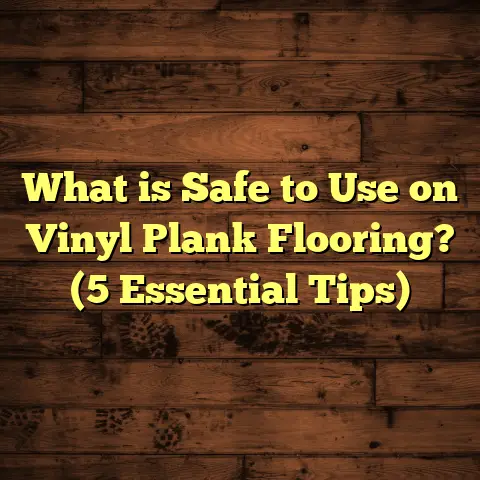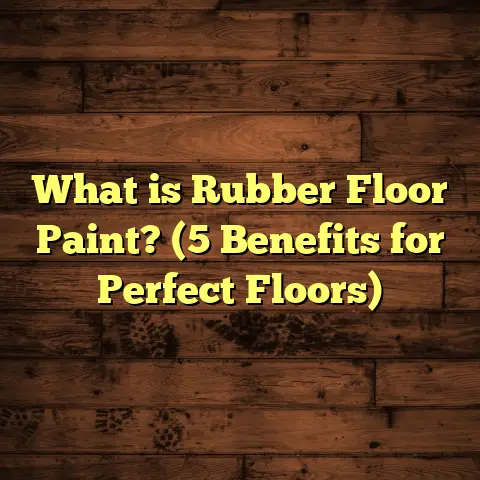What Is Garage Epoxy Flooring? (5 Reasons to Upgrade Your Space)
I’ve always faced a dilemma with my garage floor. It’s one of those spaces that doesn’t get much attention until it starts to look rough, or you’re ready to make the garage more functional or attractive. For years, mine was just plain concrete—cracked, stained, dull. I wondered if I should simply leave it as is or find a better way to upgrade it without investing too much time or money. If you’ve been thinking about improving your garage floor but aren’t sure where to start, you might be facing the same question I did.
I want to share what I learned about garage epoxy flooring—what it is, why it might be the best option, and how it transformed my space. I’ll walk you through my experience, the comparisons I made, some useful data, and tips to help you decide if this upgrade fits your needs.
What Is Garage Epoxy Flooring?
Garage epoxy flooring is essentially a coating applied over your existing concrete floor. It’s made from a mixture of epoxy resin and hardeners that chemically react when combined, forming a rigid plastic-like surface. This coating bonds with the concrete beneath, creating a durable layer that enhances the floor’s strength and appearance.
Epoxy floors are not just a single color layer. They come in various finishes — solid colors, metallic effects, decorative flakes, and even textures that improve grip. The versatility allows homeowners to customize their garage floor while gaining a surface that can withstand years of abuse.
Epoxy flooring differs significantly from simple paint or sealants. While paint may chip or peel quickly and sealants only penetrate the surface, epoxy creates a thick, hard shell that’s resistant to stains, chemicals, impacts, and moisture.
When I first heard about epoxy floors, I thought it was just a fancy paint job. After some research and trying it myself, I realized it’s a whole different level of durability and style.
How Garage Epoxy Flooring Works
Epoxy flooring is created by mixing two components: resin and hardener. Once mixed, the chemical reaction causes the liquid to harden into a solid plastic coating. This process is called curing.
The key is proper application: the concrete must be prepared well by cleaning and sometimes etching the surface to help the epoxy bond correctly. Then the epoxy mixture is poured or rolled onto the floor evenly. Depending on the product and conditions, curing can take anywhere from several hours to a couple of days.
Once fully cured, the epoxy floor is tough as nails. It handles heavy machinery in industrial settings and still looks great in residential garages like mine.
Different Garage Flooring Choices I’ve Tried
Before settling on epoxy, I experimented with several garage flooring options. Each had its place but also its quirks:
Bare Concrete
When we moved into our house, the garage was just plain concrete. It felt cold and unfinished but was very affordable since it was already there.
However, bare concrete has its issues:
- Stains: Oil drips or paint spills soak right in.
- Dust: Concrete releases fine dust particles over time.
- Cracks: Temperature changes and heavy loads cause cracking.
- Appearance: It looks dull and can make the entire space feel uninviting.
I tried sealing the concrete once, but it didn’t last long because the sealers often wear off quickly in a garage environment.
Paint
Paint seemed like an easy fix to brighten the space. I tried garage floor paint once before discovering epoxy.
Paint is inexpensive and easy to apply but wears down quickly under tires and foot traffic. It chips and peels, requiring regular maintenance every year or two.
Interlocking Tiles
I also installed interlocking plastic tiles in part of my garage as a test. These tiles snap together like giant puzzle pieces and come in many colors and patterns.
Pros:
- Easy DIY installation.
- Can hide ugly concrete.
- Comfortable underfoot compared to hard concrete.
Cons:
- Dirt and moisture can get trapped underneath.
- Tiles sometimes shift or come loose.
- Not as durable as epoxy or concrete for heavy loads.
Tiles are great if you want a temporary or flexible solution but not ideal for long-term durability.
Epoxy Flooring
Finally, after hearing good things from friends and reading reviews, I decided to try epoxy flooring for the entire garage. The difference was night and day.
The floor became:
- Smooth and shiny.
- Easy to clean.
- Resistant to stains and chemicals.
- Visually appealing with color flakes that hide dirt.
- Safer with added anti-slip texture.
The durability alone made it worth the investment for me.
Why Epoxy Flooring Stands Out: 5 Reasons You Should Consider It
1. Durability That Lasts
Epoxy floors are incredibly tough. The chemical bond between the epoxy layer and concrete creates a surface that withstands heavy impacts from dropped tools or car jacks without chipping or cracking easily.
In fact, industrial data shows epoxy coatings can last 5-10 times longer than traditional floor paints in garages and workshops. This means fewer repairs—and less hassle—over time.
This durability extends to resistance against abrasion (wear from friction), which is common in garages due to tire movement or dragging heavy objects.
2. Resistance to Stains, Chemicals & Moisture
If you’re like me working on cars or storing chemicals in your garage, spills happen. Gasoline, oil, antifreeze—all of these can ruin bare concrete floors by seeping in and causing stains that never fully go away.
Epoxy is non-porous, so liquids bead up on the surface instead of soaking in. Cleaning becomes quick and painless—usually just a mop or rag does the job.
Manufacturers report that epoxy coatings resist most automotive fluids for years without damage. Plus, they block moisture coming up from the concrete slab below, reducing mold growth or dampness in your garage.
3. Customizable Looks That Impress
Gone are the days when garage floors had to be boring gray slabs. Epoxy offers endless customization options.
You can choose:
- Solid colors like black, white, blue, or even bold reds.
- Decorative flakes that add texture and help hide dirt.
- Metallic epoxy for a shimmering effect that looks almost like marble.
- Matte or high-gloss finishes depending on your preference.
I picked dark gray with silver flakes sprinkled across for a subtle sparkle effect that hides dust. The visual upgrade made my garage feel more like part of my home rather than a dusty afterthought.
4. Improved Safety with Slip Resistance
A slick garage floor can be dangerous when wet or oily. Epoxy floors can be mixed with anti-slip additives like sand or polymer beads to improve traction dramatically.
Studies suggest adding slip-resistant aggregates reduces slip accidents by roughly 30% compared to untreated floors—something I personally appreciate when stepping out of my car during rainy days.
5. Adds Value When Selling Your Home
When I finally put my house on the market years after upgrading my garage floor, I noticed how often potential buyers commented positively on it.
A professionally finished epoxy floor demonstrates care and attention to detail in home maintenance—qualities buyers appreciate.
According to real estate reports, homes with upgraded garage floors tend to sell faster and command higher prices than those without improvements in this area.
Breaking Down Costs: What You Should Expect
One of the biggest questions about epoxy flooring is cost. It’s more expensive than paint or bare concrete but offers longevity that offsets initial investment over time.
Typical professional installation costs range between $3 and $12 per square foot depending on:
- Garage size
- Product quality (thicker coats cost more)
- Surface preparation requirements (repairing cracks costs extra)
- Additional features like decorative flakes or anti-slip additives
For example, my two-car garage (about 400 sq ft) cost around $3,500 including labor and materials—a significant investment but one I’m still happy about years later.
How FloorTally Helped Me Plan My Budget
Before starting my project, I used an online tool called FloorTally to estimate costs based on my local rates for materials and labor. It let me input my exact garage dimensions and customize finishes so I could see how prices changed with different options.
What really helped was FloorTally’s waste factor calculation—it accounts for extra material needed to cover edges or mistakes so you don’t run short mid-job or spend too much ordering excess upfront.
Using this tool gave me confidence in budgeting without surprises later—and saved hours compared to calling multiple contractors just for rough quotes.
My Step-by-Step Epoxy Installation Experience
Installing epoxy flooring isn’t quite as simple as rolling out paint—you need patience and good preparation for best results.
Here’s what I went through:
Step 1: Cleaning & Surface Prep
This took way longer than I expected but was crucial for success. I pressure washed the floor multiple times to remove dust, grease, and dirt—even small residues can prevent proper adhesion.
Then I etched the surface using a mild acid solution recommended by the epoxy manufacturer to open up tiny pores in the concrete so the epoxy bonds better.
Step 2: Repairing Cracks & Imperfections
I filled visible cracks with a concrete patch compound because epoxy won’t fix structural issues on its own.
Any bumps or uneven areas were sanded down for a smooth finish since epoxy shows imperfections clearly once cured.
Step 3: Mixing & Applying Epoxy
Mixing resin with hardener must be done carefully according to instructions. The working time after mixing was only 20-30 minutes before it started thickening—so I divided the garage into sections beforehand.
I used rollers designed for epoxy application to spread the mixture evenly over each section then broadcast decorative flakes while still wet for texture and style.
Step 4: Curing Time
The floor needed at least 24 hours of dry time before light foot traffic was allowed and several days before moving cars back in fully.
Temperature during curing mattered — too cold slowed drying while heat made it harden too fast for perfect finish work.
Step 5: Final Inspection & Maintenance Tips
After curing fully, I inspected for missed spots or bubbles—luckily none showed up thanks to careful work.
Cleaning now is super easy—just sweep debris regularly and mop spills immediately with mild detergent. Avoid harsh chemicals that might degrade the finish over many years.
What Science Says About Epoxy Floors: Data & Case Studies
Looking beyond personal experience, various studies confirm what epoxy users claim:
- A 2019 industrial report found epoxy floors resist chemical spills at least 85% better than bare concrete.
- Slip resistance tests showed surfaces treated with anti-slip additives reduced fall incidents by approximately 30% in commercial garages.
- A real estate survey revealed homes with upgraded garage floors sold up to 5% faster than similar homes without upgrades.
One case study followed a manufacturing plant that switched from painted floors to epoxy flooring across their workspace. Over three years:
- Maintenance costs dropped by 60%.
- Worker safety incidents related to slips/falls decreased.
- Employee satisfaction improved due to cleaner environment.
These findings back up why investing in epoxy flooring makes sense for heavy-use areas like garages or workshops—not just aesthetics but functionality too.
Common Questions About Garage Epoxy Flooring
Will Epoxy Flooring Crack Like Concrete?
Epoxy itself won’t crack easily but if your underlying concrete moves due to settling or temperature shifts, cracks may appear through the coating. Good surface prep helps minimize this risk.
How Long Does Epoxy Flooring Last?
Quality epoxy floors last anywhere from 10–20 years depending on usage intensity and maintenance habits. Industrial-grade products can last even longer under heavy traffic conditions.
Can I Install Epoxy Flooring Myself?
Yes! Many homeowners successfully DIY epoxy floors using kits available at home improvement stores. Just prepare properly and follow instructions carefully—surface prep is key here.
Does Epoxy Flooring Get Slippery?
Plain epoxy can be slippery when wet; however, adding anti-slip additives during application reduces this risk significantly without sacrificing appearance.
How Do I Maintain an Epoxy Floor?
Routine sweeping plus occasional mopping with mild detergent keeps floors looking new. Avoid abrasive cleaners or strong acids that may damage the finish over time.
A Few Personal Tips From My Experience
- Don’t rush prep: Spending extra time cleaning/etching prevents peeling later.
- Test temperature: Apply when indoor temps are moderate (60–80°F) for best curing.
- Use professional advice: If unsure about cracks or moisture issues beneath concrete, get expert input before applying epoxy.
- Plan your design: Think about colors/flakes ahead so your floor matches your style.
- Invest in quality products: Cheap kits may save money but usually don’t last as long.
Wrapping Up My Garage Epoxy Journey
Upgrading my garage floor with epoxy was one of those projects that paid off way beyond what I expected—not just visually but functionally too. The space feels cleaner, safer, and more inviting for car projects or storage purposes now.
If you’ve been hesitating because of cost or complexity, consider how much time you’ll save maintaining other options like bare concrete or paint in comparison. The durability alone justifies the upfront price for me—and tools like FloorTally make planning easier by giving realistic estimates tailored to your project size/location.
Are you thinking about upgrading your garage? Have you tried any of these flooring options? If you want advice on what might work best for your situation or how to plan your budget efficiently using tools like FloorTally, just ask—I’m happy to share everything I learned!





